(完整word版)新模式英语1Unit5Lesson1教案
- 格式:doc
- 大小:25.74 KB
- 文档页数:4

Lesson5 Nice to meet you.Lesson6 What make is it?1.Warm up & Lead inT: Hello, boys an d girls. Are you ready for the class?Ss:...T: Great! First, let’s watch a short video. After watching, please tell me what the video is about.A.A new lessonB. A new studentSs:...T: Which one do you choose?S: BT: Well done! The boy is a new student and he is a Chinese (中国人).2.Happy theater(开心小剧场)T: Today we will read a story about a new student too. Please watch the cartoon and try to answer the question.Is Changwoo Chinese?No, he isn’t.3.Word club (单词俱乐部)T: This story is interesting. Now let’s see the new words in the story. (呈现单词、音标、翻译、例句、单词讲解及形象化的图片)1)Listen and repeat<1> Mr. [ˈmɪstə] 先生Hello, Mr Brown. 你好,布朗先生。
Mr 是Mister (先生)的缩写,可以用于一切男子(不论婚否)的姓或姓名的前面。
<2> good [ɡʊd] adj. 好的This is a good book. 这是一本好书。
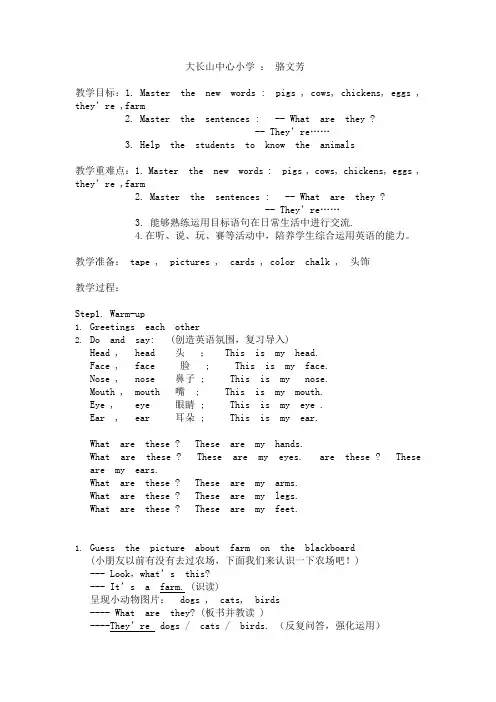
大长山中心小学:骆文芳教学目标:1. Master the new words : pigs , cows, chickens, eggs , they’re ,farm2. Master the sentences : -- What are they ?-- They’re……3. Help the students to know the animals教学重难点:1. Master the new words : pigs , cows, chickens, eggs , they’re ,farm2. Master the sentences : -- What are they ?-- They’re……3. 能够熟练运用目标语句在日常生活中进行交流.4.在听、说、玩、赛等活动中,陪养学生综合运用英语的能力。
教学准备: tape , pictures , cards , color chalk , 头饰教学过程:Step1. Warm-up1.Greetings each other2.Do and say: (创造英语氛围,复习导入)Head , head 头; This is my head.Face , face 脸 ; This is my face.Nose , nose 鼻子 ; This is my nose.Mouth , mouth 嘴 ; This is my mouth.Eye , eye 眼睛 ; This is my eye .Ear , ear 耳朵 ; This is my ear.What are these ? These are my hands.What are these ? These are my eyes. are these ? These are my ears.What are these ? These are my arms.What are these ? These are my legs.What are these ? These are my feet.1.Guess the picture about farm on the blackboard(小朋友以前有没有去过农场,下面我们来认识一下农场吧!)--- Look,what’s this?--- It’s a farm. (识读)呈现小动物图片: dogs , cats, birds---- What are they? (板书并教读 )----They’re dogs / cats / birds. (反复问答,强化运用)2. Guess : --- What animals are there on the farm?--- (让学生试着用声音帮着来猜)3. Today Daming and Sam go the farm , too. Daming’s grandma are introducingthe animals to them. Let’s have a look at the aminals together.Step3. New1.Listen to the tape with the question---- What are they?--- They’re cows.pigs.chickens. ( Oh, here are many eggs)2.Listen and repeat the text3.Follow the teacher to read4.Find the sentences containing “They’re” and read themStep4. Practice1.Play a game 1: ( Close your eyes and send them thepictures)Show the cards , then ask and answer:---- What are they?--- They’re cows / pigs / chickens / cats / birds / dogs.(采用整体问、小组问、老对问等方式练习)2.Have a match : (books , erasers , pencils .,pencil-boxes ……) --- What are they ?--- They’re …….2.Finish the listening exercisesStep5. Sum up1.Master the new words : pigs , cows, chickens, eggs ,they’re ,farm2.Master the sentences : -- What are they ?-- They’re……Step6. Homework1.Read the words and the sentences2.Can read the text and tell your parents板书设计:Module 5 Unit 1 They’re cows.(farm)---- What are they?--- They’re cows.pigs.chickens. (eggs)。
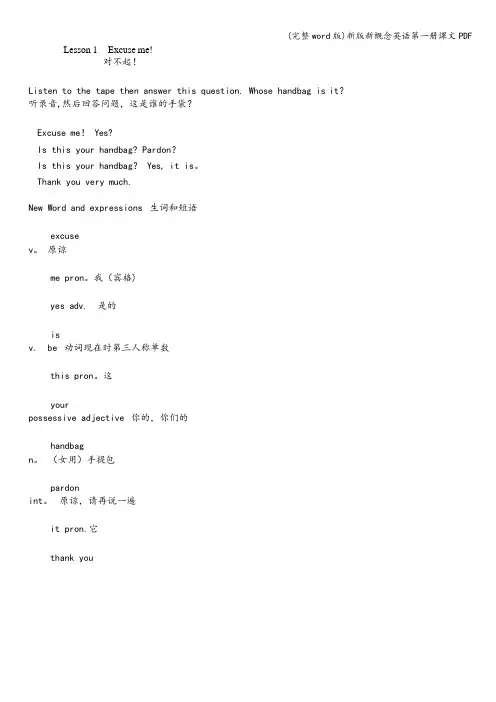
Lesson 1 Excuse me!对不起!Listen to the tape then answer this question. Whose handbag is it?听录音,然后回答问题,这是谁的手袋?Excuse me! Yes?Is this your handbag? Pardon?Is this your handbag? Yes, it is。
Thank you very much.New Word and expressions 生词和短语excusev。
原谅me pron。
我(宾格)yes adv. 是的isv. be 动词现在时第三人称单数this pron。
这yourpossessive adjective 你的,你们的handbagn。
(女用)手提包pardonint。
原谅,请再说一遍it pron.它thank you感谢你(们)very much非常地参考译文对不起什么事?这是您的手提包吗?对不起,请再说一遍。
这是您的手提包吗?是的,是我的。
非常感谢!Lesson 3 Sorry, sir.对不起,先生.Listen to the tape then answer this question.听录音,然后回答问题。
这位男士有没有要回他的雨伞?My coat and my umbrella please。
Here is my ticket。
Thank you, sir.Number five。
Here’s your umbrella and your coat. This is not my umbrella.Sorry sir。
Is this your umbrella? No, itisn’t。
Is this it? Yes, it is.Thank you very much.New words and Expressions 生词和短语umbrellan。
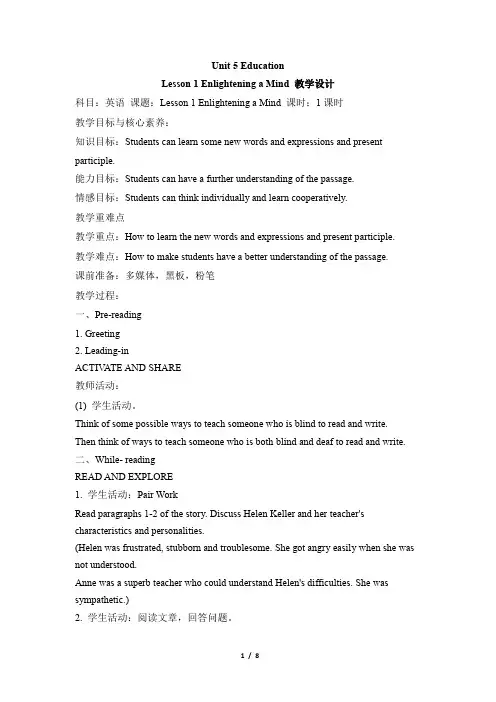
Unit 5 EducationLesson 1 Enlightening a Mind 教学设计科目:英语课题:Lesson 1 Enlightening a Mind 课时:1课时教学目标与核心素养:知识目标:Students can learn some new words and expressions and present participle.能力目标:Students can have a further understanding of the passage.情感目标:Students can think individually and learn cooperatively.教学重难点教学重点:How to learn the new words and expressions and present participle.教学难点:How to make students have a better understanding of the passage.课前准备:多媒体,黑板,粉笔教学过程:一、Pre-reading1. Greeting2. Leading-inACTIV ATE AND SHARE教师活动:(1) 学生活动。
Think of some possible ways to teach someone who is blind to read and write. Then think of ways to teach someone who is both blind and deaf to read and write.二、While- readingREAD AND EXPLORE1. 学生活动:Pair WorkRead paragraphs 1-2 of the story. Discuss Helen Keller and her teacher's characteristics and personalities.(Helen was frustrated, stubborn and troublesome. She got angry easily when she was not understood.Anne was a superb teacher who could understand Helen's difficulties. She was sympathetic.)2. 学生活动:阅读文章,回答问题。
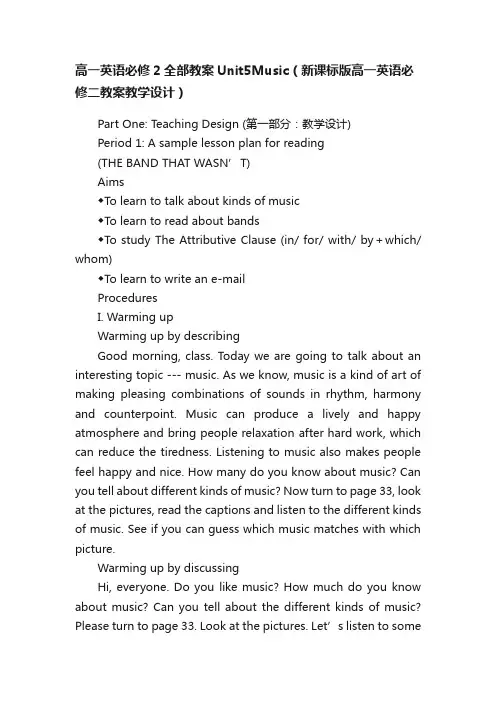
高一英语必修2全部教案Unit5Music(新课标版高一英语必修二教案教学设计)Part One: Teaching Design (第一部分:教学设计)Period 1: A sample lesson plan for reading(THE BAND THAT WASN’T)Aims◆To learn to talk about kinds of music◆To learn to read about bands◆To study The Attributive Clause (in/ for/ with/ by+which/ whom)◆To learn to write an e-mailProceduresI. Warming upWarming up by describingGood morning, class. Today we are going to talk about an interesting topic --- music. As we know, music is a kind of art of making pleasing combinations of sounds in rhythm, harmony and counterpoint. Music can produce a lively and happy atmosphere and bring people relaxation after hard work, which can reduce the tiredness. Listening to music also makes people feel happy and nice. How many do you know about music? Can you tell about different kinds of music? Now turn to page 33, look at the pictures, read the captions and listen to the different kinds of music. See if you can guess which music matches with which picture.Warming up by discussingHi, everyone. Do you like music? How much do you know about music? Can you tell about the different kinds of music? Please turn to page 33. Look at the pictures. Let’s listen to somemusic. Let’s see if you can guess which music matches with which picture.Classical music Country music Rock ‘n’ RollRap Orchestra Folk musicYes, you are right. I’m sure you will really enjoy yourselves after listening to all these beautiful music. What kind of music do you like better, Chinese or Western, classical or modern? Why? How does music make you feel? Why do you like to listen to music? Let’s discuss these questions in small groups. Try to share your opinions with one another.II. Pre-reading1.Thinking and sayingHave you heard about any of the famous bands in the world? List some if you can.For reference: I’ve heard about “The Beatles”, “Back Street Boys”, “The Eagles”, “West life” and “Pink Floyd”.2.Listening, talking and sharingLet’s listen to some pieces of music from different bands. Work in groups of four. Tell your group mates which band you like best. Why? Then the group leader is to stand up and share the group idea with the class.F or reference: I am from Group 1. Our group likes “The Beatles” best. We like their style of performances. Listening to their performances, we will feel relaxed, amused, and their performances make us think a lot about life.Do you know anything about “The Monkees”?For reference: “The Monkees” is a band that was first popular in the 1960s in America. Unlike most bands of the time, the Monkees were not formed by its members but rather by TV producers. They were a fictional band in the TV show of the samename. The band was composed of Mike Nesmith, Mickey Dolenz, Davy Jones, and Peter Tork. All the members had some musical experience. Let’s come to the reading --- The Band That Wasn’t and find more about them.III. Reading1.Reading aloud to the recordingNow please listen and read aloud to the recording of the text THE BAND THAT WASN’T. Pay attention to the pronunciation of each word and the pauses within each sentence. I will play the tape twice and you shall read aloud twice, too.2.Reading and underliningNext you are to read and underline all the useful expressions or collocations in the passage. Copy them to your notebook after class as homework.Collocations from THE BAND THAT WASN’Tdream of doing , at a concert , with sb. clapping and enjoying …, sing karaoke , be honest with oneself, get to form a band, high school students, practice one’s music, play to passers-by, in the subway, earn some extra money, begin as a TV show, play jokes on…, be based loosely on…, the TV organizers, make good music, put an advertisement in a newspaper, look for rock musicians, pretend to do sth., the attractive performances, be copied by…, support them fiercely, become more serious about…, play their own instruments, produce one’s own records, start touring, break up, in the mid-1980s, a celebration of one’s time as a real band3.Reading to identify the topic sentence of each paragraphSkim the text and identify the topic sentence of each paragraph. You may find it either at the beginning, the middle or the end of the paragraph.1st paragraph: How do people get to form a band?2nd paragraph: Most musicians meet and form a band.3rd paragraph: One band started as a TV show.4th paragraph: “The Monkees” became even more popular than “The Beatles”.3.Reading and transferring informationRead the text again to complete the tables, which list how people formed a band and how The Monkees was formed by the TV organizers and became a real band.How do people get to form a band?展开全文阅读Members High school studentsReasons They like to write and play music.Places They practice their music in someone’s home.Forms They may play to passers-by in the street or subway.Results They can earn some extra money. They may also have a chance to dream of becoming famous.How was The Monkees formed and became a real band?The Monkees in 1968 (left to right): Micky Dolenz, Peter Tork, Mike Nesmith & Davy Jonesbeginning of the band It began as a TV show.style of the performance They played jokes on each other as well as played music.first music and jokes Most of them were based loosely on the band called “The Beatles”.development of the band They became more serious about their work and started to play their own instruments and write their own songs like a real band. They produced their own records and started touring and playing their own music.changes of the band The band broke up in about 1970, but reunited in the mid-1980s. They produced a new record in 1996,which was a celebration of their time as a real band.4. Reading and understanding difficult sentencesAs you have read the text times, you can surely tell which sentences are difficult to understand. Now put your questions concerning the difficult points to me.IV. Closing downClosing down by doing exercisesTo end the lesson you are to do the comprehending exercises No. 1, 2, 3 and 4.Closing down by having a discussionDo you think the TV organizers were right to call “The Monkees” a band when they did not sing or write their own songs? Why?For reference: I don’t think the TV organizers were right to call “The Monkees” a band when they did not sing or write their own songs because singing and writing its own songs was the basis of a band.Do you agree that the jokes were more important than the music for this band? Give a reason.For reference: Yes. I think it is the jokes that really attract more fans.No. I think the purpose of forming a band is getting people to enjoy the spirit of music. It’s more important than playing jokes just to make people laugh.Closing down by retelling the form of the band The Monkees.I shall write some key words and expressions on the board. You are to retell the form of the band according to these words.For reference: begin as a TV show, the TV organizers, look for, put an advertisement in a newspaper, use actors for the other members of the band, pretend to singPeriod 2: A sample lesson plan for Learning about Language (The Attributive Clause (in/ for/ with/ by+which/ whom).AimsTo help students learn about the Attributive Clause with a preposition in front.To help students discover and learn to use some useful words and expressions.To help students discover and learn to use some useful structures.ProceduresI. Warming upWarming up by discovering useful words and expressionsTurn to page 35 and do exercises No. 1, 2 and 3 first. Check your answers against your classmates’.II. Learning about grammar1.Reading and thinkingTurn to page 34 and read with me the text of THE BAND THAT WASN’t. As you read on, pay attention to The Attributive Clause (in/ for/ with/ by+which/ whom), that is, the attributive clauses with a preposition ahead of the relative pronoun shown in the sentences.For reference: The musicians of whom the band was formed played jokes on each other as well as played music. However, after a year or so in which they became more serious about their work, “The Monkees” started to play their own instruments and write their own songs like a real band.2.Doing exercises No. 1 and 2 on page 35Turn to page 34. Look at the two sentences:The musicians of whom the band was formed played jokes on each other as well as played music.However, after a year or so in which they became more serious about their work, “The Monkees” started to play their own instruments and write their own songs like a real band.Pay attention to the structure: preposition + relative pronoun. Usually only two relative pronouns --- which and whom--- can be used in the Attributive Clause, with a preposition put before the clause. That can’t be used. Look at the screen. Here are m ore examples on this kind of structure.1.This is the reason for which he left his hometown. (=why)2.I’ll never forget the day on which we stayed together. (=when)3.This is the girl from whom I learned the news.4.The person to whom I spoke just now is the manager thatI told you about.5.I’ll show you a store in which you may buy all that you need.(=where)6.I don’t like the way in which you laughed at her.(=that)Now go on to do Exercise No. 2 on page 36, that is, to sort out the sentences.III. Ready used materials for The Attributive Clause (in/ for/ with/ by+which/ whom)In formal styles we often put a preposition before the relative pronouns which and whom:The rate at which a material heats up depends on its chemical composition.In the novel by Peters, on which the film is based, the main character is a teenager.An actor with whom Gelson had previously worked contacted him about the role.Her many friends, among whom I like to be considered, gaveher encouragement.Notice that after a preposition you can’t use who in place of whom, and you can’t use that or zero relative pronoun either: Is it right that politicians should make important decisions without consulting the public to whom they are accountable? (not --- the public to who they are accountable.)The valley in which the town lies is heavily polluted. (not --- The valley in that the town...)Arnold tried to gauge the speed at which they were traveling. (not --- the speed at they were traveling.)In informal English we usually put the preposition at the end in attributive clauses rather than at the beginning:The office which Graham led the way to was filled with books.Jim’s footballing ability, which he was noted for, had been encouraged by his parents.The playground wasn’t used by those chi ldren who it was built for.In this case we prefer who rather than whom (although whom is used in formal contexts). In restrictive attributive clauses we can also use that or zero relative pronoun instead of who or which (e.g. ...the children (that) it was built for).展开余文If the verb in attributive clauses is a two-or-three-word verb (e.g. come across, fill in, go through, look after, look up to, put up with, take on) we don’t usually put the preposition at the beginning:Your essay is one of those (which/t hat) I’ll go through tomorrow. (rather than...through which I’ll go tomorrow.) She is one of the few people (who/that) I look up to. (not ... to whom I look up.)In formal written English, we often prefer to use of whichrather than whose to talk about things:A huge amount of oil was spilled, the effects of which are still being felt. (or...whose effects are still being felt.)The end of the war, the anniversary of which is on the 16th of November, will be commemorated in cities throughout the country. (or...whose anniversary is on...)Note that we can’t use of which in place of whose in the patterns described in Unit 71B:Dorothy was able to switch between German, Polish and Russian, all of which she spoke fluently. (not..,all whose she spoke...)We can sometimes use that...of in place of of which. This is less formal than of which and whose, and is mainly used in spoken English:The school that she is head of is closing down. (or The school of which she is head...)Whose can come after a preposition in attributive clauses. However, it is more natural to put the preposition at the end in less formal contexts and in spoken English:We were grateful to Mr. Marks, in whose car we had traveled home. (or...whose car we had traveled home in.)I now turn to Freud, from whose work the following quotation is taken. (or...whose work the following quotation is taken from.)IV. Closing down by doing exercises:Join the sentence halves using which or whom after an appropriate preposition. (A)a. I would never have finished the work.b. It was primarily written.c. We know nothing.d. They got a good view.e. He learned how to play chess.f. Dennis scored three goals in the final.g. She was born.h. It was discovered.1.They climbed up to the top of a large rock.2. I would like to thank my tutor.3. She has now moved back to the house on Long Island.4. The star is to be named after Patrick Jenks.S. This is the ball.6. He is now able to beat his father.7. The book is enjoyed by adults as well as children.8. There are still many things in our solar system.Key for reference:1.They climbed up to the top of a large rock, from which they got a good view.2. I would like to thank my tutor, without whom I would never have finished the work.3. She has now moved back to the house on Long Island, in which she was born.4. The star is to be named after Patrick Jenks, by whom it was discovered.S. This is the ball. Dennis scored three goals in the final.6. He is now able to beat his father, from whom he learned how to play chess.7. The book is enjoyed by adults as well as children, about whom it was primarily written.8. There are still many things in our solar system, about which we know nothing.Are these correct or appropriate? If they are, put a√. If theyare not, give a reason, correct them and give alternatives if you can. (A)I. It's a piece of jewelry across which I came in an antique shop. --- which I came across in an antique shop. (‘came across’ is a two-word verb.)2. The extra work which she took on was starting to affect her health.3. My mother, after whom I looked for over 20 years, died last year.4. The people whom I work with are all very friendly.5. Some of the criticisms with which they had to put up were very unfair.6. He had many friends with whom he had a regular correspondence.7. The woman to who he is engaged comes from Poland.8. The forms which I had to fill in were very complicated.Rewrite these sentences so that they are more appropriate for formal written English. Use preposition + which or preposition + whose, as appropriate. (B)I. Tom Sims, whose car the weapons were found in, has been arrested. Torn Sims, in whose car the weapons were found, has been arrested.2. Tom Ham, whose novel the TV series is based on, will appear in the first episode.3. Dr Jackson owns the castle whose grounds the main road passes through.4. Tessa Parsons is now managing director of Simons, the company that she was once a secretary in.5. Allowing the weapons to be sold is an action that the Government should be ashamed of.6. The dragonfly is an insect that we know very little of.Period 3: A sample lesson plan for Using LanguageAimsTo read the story about Freddy and then enjoy and understand Beatles’ songs.To use the language by reading, listening, speaking and writing.ProceduresI. Warming up by listening and writingTurn to page 37 and read these sentences before listening to the tape. Then listen to the tape and decide true or false.II. Guided reading1. Reading and translatingRead more about Freddy’s li fe and translate it into Chinese paragraph by paragraph.2. Reading and underliningNext you are to read and underline all the useful expressions or collocations in the passage. Copy them to your notebook after class as homework.Collocations from Freddy’s lifebecome famous, visit Britain on a tour, wait for hours to get tickets for the concerts, be confident, enjoy singing and all the congratulations, the most exciting experience, sing in a TV program called “T op of the Pops, wear an expensive suit, give a performance to a TV camera, go wrong, not go out without being followed everywhere, wear sunglasses, hide in railway stations, one’s personal life, become too painful for sb., pack one’s bags3. Doing exercisesNow you are going to do exercises No. 3, 4 and 5 on page 38 following the article.Ex3: Here are the incorrect sentences which should be crossed out.1. Freddy and his band always loved being pop stars.2. His favorite program was “Top of the Pops”.3. Things went wrong because Freddy and his band hid themselves.4. They realized they had to go because they were painful.Exercise 4 Answer these questions:1. This is an open question by which students are asked about their opinions.Answers may vary.2. Answers may vary but there is information in the reading passage that may include:--- becoming rich;--- doing a job you want to do;--- having many fans;--- people enjoying your music.3. Answers may vary but information may include:--- peaceful and quiet;--- a private life away from crowds;--- a personal life which others do not discuss.Exercise 5: The main idea is No. 3. This is a story about a band that became famous and did not like it. Only No. 3 best summarizes the main idea, while all the others reflect just part of the main idea. At first, Freddy and his band wanted to be famous, but when he became famous, they were always being followed wherever they went, which they found painful.III. Guided writing1.Writing a letter for advicePlease turn to page 38 writing. Let’s read the instruction s.You and your friends want to start your own band. However, you have never played in a band before. You write an e-mail to Freddy for his advice. The e-mail is started for you, but you have to finish it.You’d better do some brainstorming in small groups before writing your letters. You should follow the procedure for brainstorming and outlining introduced in Module 1 Unit 2.Writing tips:1. In groups discuss some questions you would like to ask Freddy.2. Make a list of them and choose the best questions.3. Share your ideas with another pair; discuss all questions and then decide which ones you want to ask Freddy.4. Use each question to start a new paragraph.5. Write your question first; then add extra information to show Freddy why you need help.6. Finish the letter politely and thank Freddy for his help.2.Reading Freddy’s replyLet’s read Freddy’s reply and answer the questions:--- How was Freddy’s band formed?--- What advice does Freddy give?3.Writing a note and a paragraphPlease turn to page 74. Now in pairs you are going to decide on the best way to tell a foreign friend about one kind of Chinese folk music. What do you think they need to know before they can enjoy it? Why do you like it? Who are your favorite singers? Discuss it with your partner and write notes to remind you of your most important ideas. Then write a paragraph telling your foreign friend about the type of Chinese folk music you have chosen. Use a dictionary and other reference books to help you.展开余文IV. Further applyingFinding informationGo to the library to read or get online to search in order to find more information on music and musicians. Take notes of your findings and report them to your group mates next Monday morning.V. Closing down by filling a formMake use of the text and others to fill in the form below.How do people form a bandMembersReasonsPlacesFormsResultsClosing down by describing a bandTo end this period, I am going to have two of you to describe to the class a band whom you appreciates. W ho’d like to speak first?Part Two: Teaching Resources (第二部分:教学资源)Section 1: A text structure analysis of THE BAND THAT WASN’TI. Type of writing and summary of the ideaType of writing This is a piece of narrative writing.Main idea of the passageThe band The Monkees was formed in quite a different way. It started as a TV show, with musicians played jokes on each other as well as played music, based loosely on the band called The Beatles. As time went on, their attractive performances gained fiercely support from their fans. With their own particular style of performing their band at last became very popular in the USA.Topic sentence of 1st paragraph Have you ever wanted to be a famous singer or musician?Topic sentence of 2nd paragraph Most musicians meet and form a band because they like to play music.Topic sentence of 3rd paragraph However, there was one band that started in a different way.Top sentence of 4th paragraph Their attractive performances were copied by other groups and their fans supported them fiercely.II. A tree diagramIII. A retold passage of the text1. A possible version:Being a famous singer or musician may be the dream of many people. Becoming a member of a band may help you realize the dream. But just how can people form a band?Most musicians often meet and form a band for they are congenial with each other. High school students may also form a band to practice music together or sometimes play in the street to passers-by to earn some extra money, which is also a chance to realize their dreams of becoming famous.However, There was a band which was started in quite a different way. The musicians of whom the band was formed played jokes on each other and played music, loosely based on the Beatles. Their exciting performances were copied by other groups and were fiercely supported by their fans. That band was The Monkees. After a year or so, The Monkees became more serious of their work, playing their own instruments and writing their own music. Though it broke up in 1970, it reunited in the mid-1980s and is still popular today.Section 2: Background information on music, musicians andthe band The MonkeesI. Different types of music:Folk musicIt has been passed down from one generation to another. At first it was never written down. People learned the songs from their families, relatives, neighbors and friends in the same village. These songs were about the country life, the seasons, animals and plants, and about love and sadness in people’s lives.Pop musicIt is a kind of modern music with a strong beat and not of lasting interest, especially just favored for a short time by younger peopleRock ’n’ RollIt is also called rock and roll, a kind of modern music with strong beat, played loudly on electrical instruments, in which the singer repeats the same few simple words.JazzJazz was born in the USA around 1890. It came from work songs sung by black people and had its roots in Africa. Jazz started developing in the 1920s in the southern states. Soon it was played by white musicians, too, and reached other parts of the USA.African musicIt plays an important part in people’s lives, especially for work, and at festivals and weddings, when people dance all night long.Indian musicIt’s not written down. There is a basic pattern of no tes which the musician follows. But a lot of modern music is also written. India also produces films with music, and millions of records aresold every year.Music in the CaribbeanThe slaves who were brought from Africa developed their own kind of music. West Indians make musical instruments out of large oil cans. They hit different parts of the drum with hammers to produce different notes. This type of music has become very famous in Britain and is very good music to dance to.II. Famous musicians:Joseph Haydn(1732-1809)was an Austrian composer and is known as “the father of the symphony”. Other composers had written symphonies before Haydn, but he changed the symphony into a long piece for a large orchestra.He was born in a village in Austria, the son of a peasant. He had a beautiful singing voice. After studying music in Vienna, Haydn went to work at the court of a prince in eastern Austria, where he became director of music. Having worked there for 30 years, Haydn moved to London, where he was very successful.Wolfgang Amadeus Mozart (1756-1791)was a composer, possibly the greatest musical genius of all time. He only lived 35 years and he composed more than 600 pieces of music.Mozart was born in Salzburg, Austria. His father Leopold was a musician and orchestra conductor. Wolfgang had musical talent from a very early age. He learned to play the harpsichord in a concert for the Empress of Austria.By the time he was 14, Mozart had composed many pieces for the harpsichord, piano and violin, as well as for orchestras. While he was still a teenager, Mozart was already a big star and toured Europe giving concerts. Haydn met Mozart in 1781 and was very impressed with him. “He is the greatest composer theworld has known,” he said. The two were friends until Mozart’s death in 1791.Ludwig van Beethoven (1770-1827)was born in Bonn, Germany. He showed musical talent when he was very young, and learned to play the violin and piano from his father, who was a singer. Mozart met Beethoven and was impressed by him. “He will give something wonderful to the world,” he said. Beethoven met Haydn in 1791, but was not impressed by the older man. After they had known each other for many years, Beethoven said, “He is a good composer, but he has taught me nothing.” However, it was Haydn who encouraged Beethoven to move to Vienna. Beethoven became very popular in the Austrian capital and stayed there for the rest of his life. As he grew older, he began to go deaf. He became completely deaf during the last years of his life, but he continued composing.III. Musical instrument 乐器saxophone electrical equipment pianoguitar fluteV. What are the functions of music?Make things more lively and interestingMake things better for people to understand and enjoyExpress people’s feelingMake people feel goodHelp people forget their painAttract people’s attentionhelp people to remember things wellVI. The introduction of the band The MonkeesThe Monkees were a four-person band who appeared in an American television series of the same name, which ran on NBC from 1966 to 1968. The Monkees were formed in 1965 in LosAngeles, California and disbanded in 1970. At their peak they were one of the most popular musical acts of their time.Several reunions of the original lineup have taken place. The first reunion lasted from 1986 to 1989, and a second regrouping took place between 1996-1997. The Monkees last worked together for a brief period in 2001.Section 3: Words and expressions from Unit 5 THE BAND THAT WASN’TI. Words for Readingclassicaladj. (of music)put together and arranged(composed) with serious artistic intentions; having an attraction that lasts over a long period of time(as opposed to popular or folk music)(音乐)古典的Bach and Beethoven wrote classical music. the classical music of India/ the classical symphonyrollvt.&vi. 1. to (cause to) move along by turning over and over (使)滚动We rolled the barrels of oil onto the ship. Tears were rolling down her cheeks. 2. to move steadily and smoothly along(as) on wheels(车轮)滚动;转动The train rolled slowly into the station. The waves rolled over the sand. 3. (of a ship)to swing from side to side with the movement of the waves摇摆;摇晃The ship rolled so heavily that we were all sick.4. keep the ball rolling: to keep things active and moving(使事情,工作等)继续进行下去;不松懈5. set the ball rolling: to be the first to do something, hoping that others will follow带动;带头(希望他人跟随)I’ll sing a song first, just to set the ball rolling.folkadj. of, connected with, or being music or any other art that has grown up among working and/or country people as an。
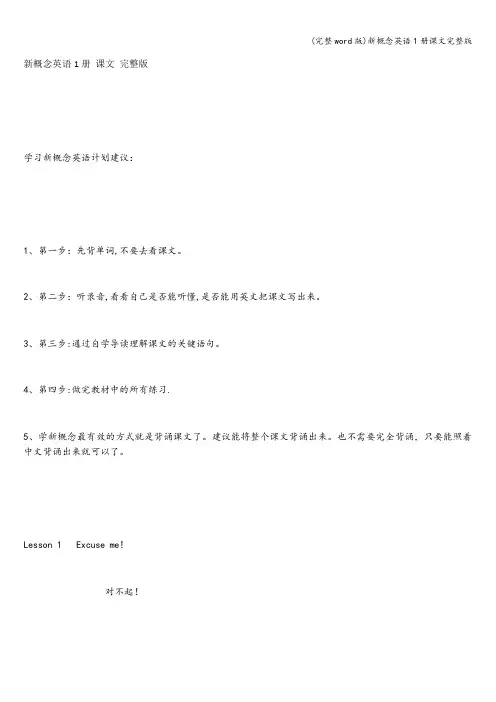
新概念英语1册课文完整版学习新概念英语计划建议:1、第一步:先背单词,不要去看课文。
2、第二步:听录音,看看自己是否能听懂,是否能用英文把课文写出来。
3、第三步:通过自学导读理解课文的关键语句。
4、第四步:做完教材中的所有练习.5、学新概念最有效的方式就是背诵课文了。
建议能将整个课文背诵出来。
也不需要完全背诵,只要能照着中文背诵出来就可以了。
Lesson 1 Excuse me!对不起!Excuse me!Yes?Is this your handbag? Pardon?Is this your handbag? Yes, it is.Thank you very much。
参考译文对不起什么事?这是您的手提包吗?对不起,请再说一遍。
这是您的手提包吗?是的,是我的。
非常感谢!Lesson 3 Sorry, sir。
对不起,先生.My coat and my umbrella please.Here is my ticket。
Thank you, sir.Number five。
Here's your umbrella and your coat。
This is not my umbrella.Sorry sir.Is this your umbrella?No, it isn’t.Is this it?Yes, it is.Thank you very much.参考译文请把我的大衣和伞拿给我.这是我(寄存东西)的牌子。
谢谢,先生.是5号.这是您的伞和大衣这不是我的伞。
对不起,先生。
这把伞是您的吗?不,不是!这把是吗?是,是这把非常感谢。
Lesson 5 Nice to meet you很高兴见到你.MR. BLAKE: Good morning.STUDENTS: Good morning, Mr。
Blake.MR。
BLAKE: This is Miss Sophie Dupont。
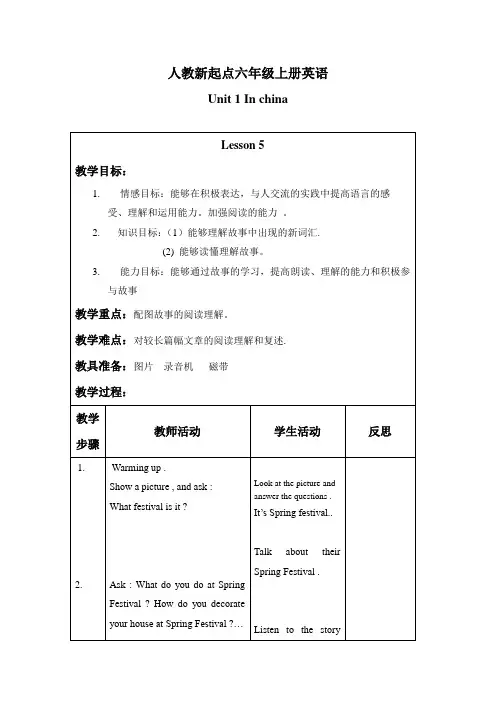
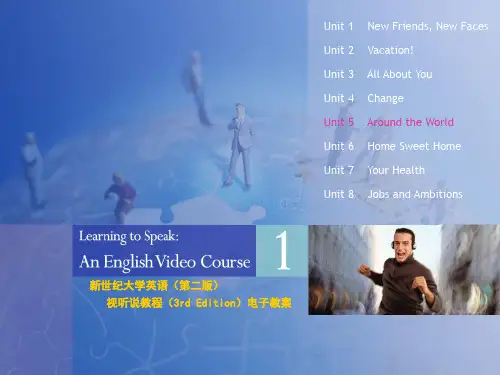
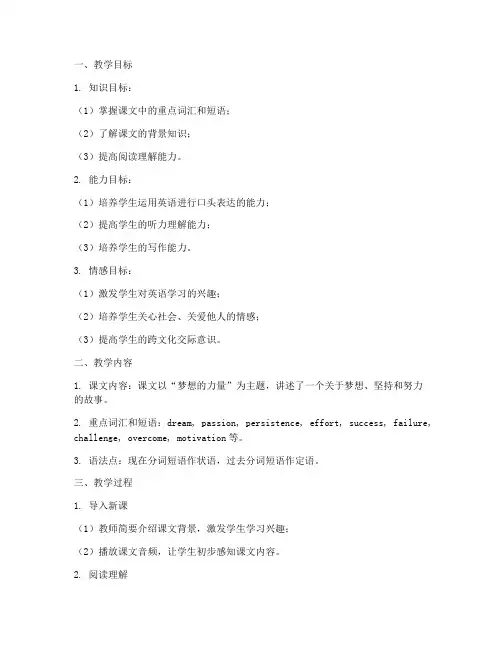
一、教学目标1. 知识目标:(1)掌握课文中的重点词汇和短语;(2)了解课文的背景知识;(3)提高阅读理解能力。
2. 能力目标:(1)培养学生运用英语进行口头表达的能力;(2)提高学生的听力理解能力;(3)培养学生的写作能力。
3. 情感目标:(1)激发学生对英语学习的兴趣;(2)培养学生关心社会、关爱他人的情感;(3)提高学生的跨文化交际意识。
二、教学内容1. 课文内容:课文以“梦想的力量”为主题,讲述了一个关于梦想、坚持和努力的故事。
2. 重点词汇和短语:dream, passion, persistence, effort, success, failure, challenge, overcome, motivation等。
3. 语法点:现在分词短语作状语,过去分词短语作定语。
三、教学过程1. 导入新课(1)教师简要介绍课文背景,激发学生学习兴趣;(2)播放课文音频,让学生初步感知课文内容。
2. 阅读理解(1)教师引导学生阅读课文,找出重点词汇和短语;(2)学生分组讨论课文内容,分享各自的理解和感受;(3)教师总结课文内容,强调重点词汇和短语。
3. 语法讲解(1)教师讲解现在分词短语作状语和过去分词短语作定语的用法;(2)学生进行练习,巩固所学语法知识。
4. 口语练习(1)教师设计情景对话,让学生运用课文中的词汇和短语进行口语表达;(2)学生分组进行角色扮演,提高口语交际能力。
5. 听力训练(1)播放课文音频,让学生听写课文内容;(2)教师讲解听写中的错误,帮助学生提高听力理解能力。
6. 写作练习(1)教师给出写作题目,要求学生运用所学词汇和语法知识进行写作;(2)学生完成写作任务,教师进行批改和点评。
7. 课堂小结(1)教师总结本节课所学内容,强调重点;(2)布置课后作业,巩固所学知识。
四、教学评价1. 课堂参与度:观察学生在课堂上的表现,如提问、回答问题、小组讨论等;2. 作业完成情况:检查学生的课后作业,了解学生对知识的掌握程度;3. 口语表达:评价学生在口语练习中的表现,如发音、语法、词汇运用等;4. 写作能力:评价学生的写作水平,如结构、内容、语言表达等。
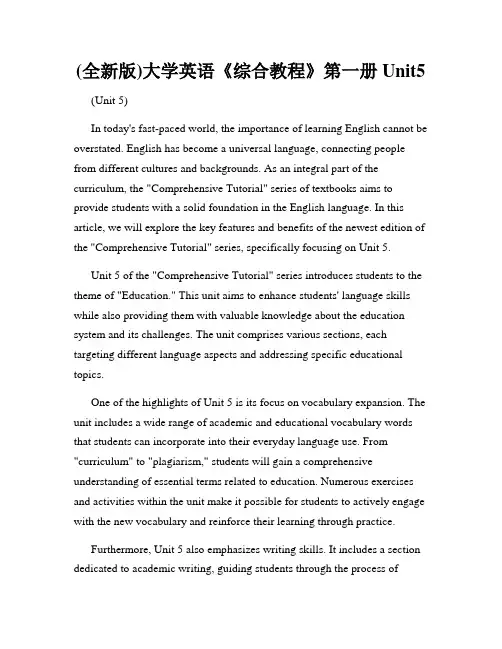
(全新版)大学英语《综合教程》第一册Unit5 (Unit 5)In today's fast-paced world, the importance of learning English cannot be overstated. English has become a universal language, connecting people from different cultures and backgrounds. As an integral part of the curriculum, the "Comprehensive Tutorial" series of textbooks aims to provide students with a solid foundation in the English language. In this article, we will explore the key features and benefits of the newest edition of the "Comprehensive Tutorial" series, specifically focusing on Unit 5.Unit 5 of the "Comprehensive Tutorial" series introduces students to the theme of "Education." This unit aims to enhance students' language skills while also providing them with valuable knowledge about the education system and its challenges. The unit comprises various sections, each targeting different language aspects and addressing specific educational topics.One of the highlights of Unit 5 is its focus on vocabulary expansion. The unit includes a wide range of academic and educational vocabulary words that students can incorporate into their everyday language use. From "curriculum" to "plagiarism," students will gain a comprehensive understanding of essential terms related to education. Numerous exercises and activities within the unit make it possible for students to actively engage with the new vocabulary and reinforce their learning through practice.Furthermore, Unit 5 also emphasizes writing skills. It includes a section dedicated to academic writing, guiding students through the process ofconstructing well-structured essays. The unit introduces students to various types of essays commonly encountered in an academic setting, such as argumentative essays and descriptive essays, providing them with a step-by-step approach to master each style. By following the provided guidelines and practicing the given exercises, students can enhance their writing abilities and prepare themselves for future academic challenges.In addition to vocabulary expansion and writing skills, Unit 5 also focuses on developing students' listening and speaking skills. Through a variety of authentic recordings and interviews, students are exposed to real-life situations related to education. They have the opportunity to listen to different accents and improve their listening comprehension skills. The unit also incorporates interactive speaking activities, enabling students to engage in discussions and express their opinions on a range of educational topics. These activities foster a collaborative learning environment, encouraging students to actively participate and communicate in English.Another unique component of Unit 5 is its incorporation of cultural insights. The unit explores the significance of education in different cultures around the world, shedding light on educational practices, beliefs, and traditions from diverse perspectives. By understanding the cultural nuances associated with education, students develop a global mindset and become more open-minded individuals.To enhance self-assessment and independent learning, Unit 5 includes regular self-evaluation exercises and a comprehensive review section at the end of the unit. These features allow students to gauge their progress,identify areas of improvement, and reinforce their understanding of the unit's content.In conclusion, Unit 5 of the "Comprehensive Tutorial" series offers a comprehensive and engaging approach to learning English in the context of education. Through its focus on vocabulary expansion, writing skills, listening and speaking abilities, cultural insights, and self-assessment, the unit equips students with the necessary tools to excel in their language learning journey. The newest edition of the textbook serves as a valuable resource for both teachers and students, providing a solid foundation for developing a strong command of the English language.。
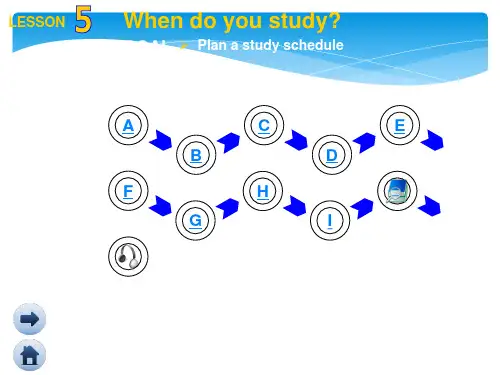
教 案 首 页
授课日期
班 级
课题:《新模式英语1》Unit5 Our Community Lesson1 Places and Services_
教学目的要求:1.识别社区里各种公共服务场所的名称;______________
2.了解我们在社区里可以获得哪些服务,能用对话交流;
3.热爱和珍惜我们的社区环境。______________________
教学重点、难点:1.重点:掌握社区公共服务场所的作用_______________
2.难点:与服务场所相关的单词____________________
授课方法:讲授法、演示法、讨论法、问答法________________________
教学参考及教具(含多媒体教学设备):
教材、《新模式英语1》配套练习册、PPT、听力CD、词汇卡、黑板、粉笔
授课执行情况及分析:
板书设计或授课提纲
教学内容与过程
教学环节 教学内容 师生活动
Warm-up &
Introduction
Presentation 1
Presentation 2
1. 展示嬉戏谷照片,回顾秋游的快乐时光,去这类主题
公园玩是同学们业余生活不可缺少的一部分,每个城
市也都有类似的主题乐园,我们把这样的公共场所称
为Parks & Receation. 2. 解析receation:重塑、再创造、消遣、娱乐 词根:create,前缀:re(再), 后缀:tion (构成名词,表行为、状态等) 3. 公园和休闲娱乐场所又是我们生活的社区里面不可缺少的服务场所。那我们这个单元的主题就是(社区)community。(练习拼读) 4. What’s the community? 聚居在一定地域范围内的人们所组成的社会生活共同体,包括一定数量的人口、一定范围的地域、一定规模的设施、一定特征的文化、一定类型的组织。 1. Ask:Are there any important places in \near your community? 2. 将学生按座位分成左右两大阵营进行讨论交流,要求每个队伍出两位同学上黑板罗列交流结果。(尽量用英文,实在不会可以写中文) 3. 提示语: Where do you play with your friends? Where do you buy food or clothes? Where do you get money? If you are ill, where can you go? Where can you mail letters? Where can your cars go if they are hungry? What will you do if you are in trouble? ...... 4. 老师出示与教材相关的图片和单词,结合同学们罗列的公共场所名称讲解单词,使学生理解,并对本课生词有个大致印象,以便后面的深入学习。 1. 同桌合作,自学Exercise C中的单词词组,边学边添加标注。 2. 老师将方框中的单词逐个解释。 (1)简单讲解:park,house, doctor’s office, hospital,playground (学生已学过且简单) 解析本课生词有利于学
生理解并有效记忆单
词。
将单词按音节拆分,借
助自然拼读方法复习单
词。
提示学生听清老师的要
求,老师读完提示语之
后再进行前后左右的交
流讨论,鼓励学生积极
汇报本组交流结果。
师范读,生跟读,有读
音上的偏差老师要及时
纠正。
学生自学,给生词添加
标注,老师下座位查看
指导,几分钟后再集体
学习。
教学内容与过程
教学环节 教学内容 师生活动
Practice Presentation 3 (2)着重解释: A: hostel:比宾馆装修简单一点,服务没有那么全。 B:motel:汽车旅馆 motor+hotel 一般位于公路旁或郊区,便于机动车驾驶员投宿,楼下车库连接楼上的房间,为行车旅客提供一些服务。 C:tennis court: court一般多用于球类运动的活动场地。 3.熟悉了这些内容,我们要将这些场地进行分类,老师往黑板上贴一个分类词卡,然后请学生说说这个类别下有多少场所名称?当分类得到大家的认可,就请学生们写到书上对应的位置上去。 4.PPT呈现这些分类,带学生朗读。 (1).Lodging:hostel, hotel, motel (2).Medical Care: hospital, dentist’s office, doctor’s office (3). Parks & Recreation:tennis court, playground, park (4). Residential Areas: apartment, mobile home, house (5). Public Services: public library, post office, DWV (6). Emergency: police apartment, fire station 1. Listen and write the correct numbers under the
pictures. 听场所描述,在对应的图片下面标上数字序号。 1. 认识了这些公共服务场所,那我们在这些地方能享受什么服务呢?生活中遇到困难时能得到何种帮助? 2. 请学生看表格,师生共读表格 Place Problem or Service hospital My sister is ill. bank I need to get some money. DMV I need a driver’s license. post office I need to send a letter. tennis court I want to play tennis with my friend. dentist’s office My mother has a toothache. library I want to read some books there. supermarket I need some bread and milk. ...... 学生开火车说,这部分单词量多,尽量让大部分学生有机会回答。 先带学生看听力图片,看懂题目并做出预测,强调这是做听力的第一
步,提示学生这篇听力
较难,学生只需要听的
时候筛选关键词,就可
以作出判断,关键词一般
都是学生容易懂的。
教学内容与过程
教学环节 教学内容 师生活动
Practice Conclusion Homework Study the conversation and practice the conversations
with your partner with new information.
(1)A: Where are you going?
B: I’m going to the hospital.
A: Why?
B: My sister is very sick.
(2)A:Where do you go?
B:I go to the basketball court.
A:Why?
B: I want to play basketball with my brothers.
替换掉横线部分,用表格中的信息仿编对话,请学生
来展示。
我们通过本课学习,基本掌握了我们生活的社区里各
种服务场所的单词,明白了这些服务的重要性,希望同学
们热爱并珍惜我们的生活环境。
模仿黑板上的社区介绍完成一段小短文,写在英语本
上。
练习对话环节考查学生
的综合运用能力,用上
已有知识,结合新学的
知识,编出顺畅的对话。
老师要走过每个学生,
保证他们都开口练说。
教
学
反
思